Angular-Resolved Thomson Parabola Spectrometer for Laser-Driven Ion Accelerators
Abstract
:1. Introduction
2. Materials and Methods
2.1. Thomson Parabola Design and Operation
2.2. Multi-Pinhole Thomson Parabola Spectrometer
3. Experimental Test and Results
4. Discussion
Author Contributions
Funding
Institutional Review Board Statement
Informed Consent Statement
Data Availability Statement
Acknowledgments
Conflicts of Interest
Abbreviations
| TP | Thomson parabola |
| HHR | High repetition rate |
| MCP | Microchannel plate |
| CPA | Chirped pulse amplification |
| IP | Imaging plate |
| TNSA | Target normal sheath acceleration |
| RPA | Radiation pressure acceleration |
| RCF | Radiochromic film |
| FWHM | Full width at half-maximum |
| iWASP | Ion-wide angle spectrometer |
| CSA | Collisionless shock acceleration |
References
- Strickland, D.; Mourou, G. Compression of amplified chirped optical pulses. Opt. Commun. 1985, 55, 447–449. [Google Scholar] [CrossRef]
- Yoon, J.W.; Kim, Y.G.; Choi, I.W.; Sung, J.H.; Lee, H.W.; Lee, S.K.; Nam, C.H. Realization of laser intensity over 1023W/cm2. Optica 2021, 8, 630–635. [Google Scholar] [CrossRef]
- Daido, H.; Nishiuchi, M.; Pirozhkov, A.S. Review of laser-driven ion sources and their applications. Rep. Prog. Phys. 2012, 75, 056401. [Google Scholar] [CrossRef] [PubMed]
- Macchi, A.; Borghesi, M.; Passoni, M. Ion acceleration by superintense laser-plasma interaction. Rev. Mod. Phys. 2013, 85, 751–793. [Google Scholar] [CrossRef] [Green Version]
- Esarey, E.; Schroeder, C.B.; Leemans, W.P. Physics of laser-driven plasma-based electron accelerators. Rev. Mod. Phys. 2009, 81, 1229–1285. [Google Scholar] [CrossRef]
- Chen, H.; Wilks, S.C.; Meyerhofer, D.D.; Bonlie, J.; Chen, C.D.; Chen, S.N.; Courtois, C.; Elberson, L.; Gregori, G.; Kruer, W.; et al. Relativistic Quasimonoenergetic Positron Jets from Intense Laser-Solid Interactions. Phys. Rev. Lett. 2010, 105, 015003. [Google Scholar] [CrossRef]
- Roth, M.; Jung, D.; Falk, K.; Guler, N.; Deppert, O.; Devlin, M.; Favalli, A.; Fernandez, J.; Gautier, D.; Geissel, M.; et al. Bright Laser-Driven Neutron Source Based on the Relativistic Transparency of Solids. Phys. Rev. Lett. 2013, 110, 044802. [Google Scholar] [CrossRef] [Green Version]
- Ter-Avetisyan, S.; Schnürer, M.; Polster, R.; Nickles, P.; Sandner, W. First demonstration of collimation and monochromatisation of a laser accelerated proton burst. Laser Part. Beams 2008, 26, 637–642. [Google Scholar] [CrossRef]
- Toncian, T.; Borghesi, M.; Fuchs, J.; d’Humières, E.; Antici, P.; Audebert, P.; Brambrink, E.; Cecchetti, C.A.; Pipahl, A.; Romagnani, L.; et al. Ultrafast Laser-Driven Microlens to Focus and Energy-Select Mega-Electron Volt Protons. Science 2006, 312, 410–413. [Google Scholar] [CrossRef] [Green Version]
- Borghesi, M.; Mackinnon, A.J.; Campbell, D.H.; Hicks, D.G.; Kar, S.; Patel, P.K.; Price, D.; Romagnani, L.; Schiavi, A.; Willi, O. Multi-MeV Proton Source Investigations in Ultraintense Laser-Foil Interactions. Phys. Rev. Lett. 2004, 92, 055003. [Google Scholar] [CrossRef]
- Santos, J.J.; Bailly-Grandvaux, M.; Giuffrida, L.; Forestier-Colleoni, P.; Fujioka, S.; Zhang, Z.; Korneev, P.; Bouillaud, R.; Dorard, S.; Batani, D.; et al. Laser-driven platform for generation and characterization of strong quasi-static magnetic fields. New J. Phys. 2015, 17, 083051. [Google Scholar] [CrossRef]
- Apiñaniz, J.I.; Malko, S.; Fedosejevs, R.; Cayzac, W.; Vaisseau, X.; De Luis, D.; Gatti, G.; McGuffey, C.; Bailly-Grandvaux, M.; Bhutwala, K.; et al. A quasi-monoenergetic short time duration compact proton source for probing high energy density states of matter. Sci. Rep. 2021, 11, 6881. [Google Scholar] [CrossRef] [PubMed]
- Malko, S.; Cayzac, W.; Ospina-Bohorquez, V.; Bhutwala, K.; Bailly-Grandvaux, M.; McGuffey, C.; Fedosejevs, R.; Vaisseau, X.; Tauschwitz, A.; Aginako, J.A.; et al. Proton stopping measurements at low velocity in warm dense carbon. Nat. Commun. 2017. [Google Scholar] [CrossRef]
- Patel, P.K.; Mackinnon, A.J.; Key, M.H.; Cowan, T.E.; Foord, M.E.; Allen, M.; Price, D.F.; Ruhl, H.; Springer, P.T.; Stephens, R. Isochoric Heating of Solid-Density Matter with an Ultrafast Proton Beam. Phys. Rev. Lett. 2003, 91, 125004. [Google Scholar] [CrossRef] [PubMed] [Green Version]
- Roth, M.; Cowan, T.E.; Key, M.H.; Hatchett, S.P.; Brown, C.; Fountain, W.; Johnson, J.; Pennington, D.M.; Snavely, R.A.; Wilks, S.C.; et al. Fast Ignition by Intense Laser-Accelerated Proton Beams. Phys. Rev. Lett. 2001, 86, 436–439. [Google Scholar] [CrossRef] [PubMed]
- Mirani, F.; Maffini, A.; Casamichiela, F.; Pazzaglia, A.; Formenti, A.; Dellasega, D.; Russo, V.; Vavassori, D.; Bortot, D.; Huault, M.; et al. Integrated quantitative PIXE analysis and EDX spectroscopy using a laser-driven particle source. Sci. Adv. 2021, 7, eabc8660. [Google Scholar] [CrossRef]
- Spencer, I.; Ledingham, K.; Singhal, R.; McCanny, T.; McKenna, P.; Clark, E.; Krushelnick, K.; Zepf, M.; Beg, F.; Tatarakis, M.; et al. Laser generation of proton beams for the production of short-lived positron emitting radioisotopes. Nucl. Instrum. Methods Phys. Res. Sect. B 2001, 183, 449–458. [Google Scholar] [CrossRef]
- Ledingham, K.W.; Bolton, P.R.; Shikazono, N.; Ma, C.M. Towards Laser Driven Hadron Cancer Radiotherapy: A Review of Progress. Appl. Sci. 2014, 4, 402–443. [Google Scholar] [CrossRef]
- Volpe, L.; Fedosejevs, R.; Gatti, G.; Pérez-Hernández, J.A.; Méndez, C.; Apiñaniz, J.; Vaisseau, X.; Salgado, C.; Huault, M.; Malko, S.; et al. Generation of high energy laser-driven electron and proton sources with the 200 TW system VEGA 2 at the Centro de Laseres Pulsados. High Power Laser Sci. Eng. 2019, 7, e25. [Google Scholar] [CrossRef] [Green Version]
- Puyuelo Valdes, P.; de Luis, D.; Hernandez, J.; Apiñaniz, J.; Curcio, A.; Henares, J.L.; Huault, M.; Perez-Hernandez, J.A.; Roso, L.; Gatti, G.; et al. Implementation of a thin, flat water target capable of high-repetition-rate MeV-range proton acceleration in a high-power laser at the CLPU. Plasma Phys. Control. Fusion 2022, accepted. [Google Scholar] [CrossRef]
- Thomson, J. XLVII. On rays of positive electricity. Lond. Edinb. Dublin Philos. Mag. Sci. 1907, 13, 561–575. [Google Scholar] [CrossRef] [Green Version]
- Bolton, P.R.; Borghesi, M.; Brenner, C.; Carroll, D.C.; De Martinis, C.; Fiorini, F.; Flacco, A.; Floquet, V.; Fuchs, J.; Gallegos, P.; et al. Instrumentation for diagnostics and control of laser-accelerated proton (ion) beams. Phys. Medica 2014, 30, 255–270. [Google Scholar] [CrossRef] [PubMed] [Green Version]
- Cobble, J.A.; Flippo, K.A.; Offermann, D.T.; Lopez, F.E.; Oertel, J.A.; Mastrosimone, D.; Letzring, S.A.; Sinenian, N. High-resolution Thomson parabola for ion analysis. Rev. Sci. Instrum. 2011, 82, 113504. [Google Scholar] [CrossRef] [PubMed]
- Harres, K.; Schollmeier, M.; Brambrink, E.; Audebert, P.; Blažević, A.; Flippo, K.; Gautier, D.C.; Geißel, M.; Hegelich, B.M.; Nürnberg, F.; et al. Development and calibration of a Thomson parabola with microchannel plate for the detection of laser-accelerated MeV ions. Rev. Sci. Instrum. 2008, 79, 093306. [Google Scholar] [CrossRef] [PubMed]
- Huault, M.; De Luis, D.; Apiñaniz, J.I.; De Marco, M.; Salgado, C.; Gordillo, N.; Gutiérrez Neira, C.; Pérez-Hernández, J.A.; Fedosejevs, R.; Gatti, G.; et al. A 2D scintillator-based proton detector for high repetition rate experiments. High Power Laser Sci. Eng. 2019, 7, e60. [Google Scholar] [CrossRef] [Green Version]
- Cowan, T.E.; Fuchs, J.; Ruhl, H.; Kemp, A.; Audebert, P.; Roth, M.; Stephens, R.; Barton, I.; Blazevic, A.; Brambrink, E.; et al. Ultralow Emittance, Multi-MeV Proton Beams from a Laser Virtual-Cathode Plasma Accelerator. Phys. Rev. Lett. 2004, 92, 204801. [Google Scholar] [CrossRef]
- Brack, F.E.; Kroll, F.; Gaus, L.; Bernert, C.; Beyreuther, E.; Cowan, T.E.; Karsch, L.; Kraft, S.; Kunz-Schughart, L.A.; Lessmann, E.; et al. Spectral and spatial shaping of laser-driven proton beams using a pulsed high-field magnet beamline. Sci. Rep. 2020, 10, 9118. [Google Scholar] [CrossRef]
- Milluzzo, G.; Petringa, G.; Catalano, R.; Cirrone, G.A. Handling and dosimetry of laser-driven ion beams for applications. Eur. Phys. J. Plus. 2021, 136, 1170. [Google Scholar] [CrossRef]
- Lindau, F.; Lundh, O.; Persson, A.; McKenna, P.; Osvay, K.; Batani, D.; Wahlström, C.G. Laser-Accelerated Protons with Energy-Dependent Beam Direction. Phys. Rev. Lett. 2005, 95, 175002. [Google Scholar] [CrossRef] [Green Version]
- Schreiber, J.; Ter-Avetisyan, S.; Risse, E.; Kalachnikov, M.P.; Nickles, P.V.; Sandner, W.; Schramm, U.; Habs, D.; Witte, J.; Schnürer, M. Pointing of laser-accelerated proton beams. Phys. Plasmas 2006, 13, 033111. [Google Scholar] [CrossRef]
- Nakamura, T.; Mima, K.; Ter-Avetisyan, S.; Schnürer, M.; Sokollik, T.; Nickles, P.V.; Sandner, W. Lateral movement of a laser-accelerated proton source on the target’s rear surface. Phys. Rev. E 2008, 77, 036407. [Google Scholar] [CrossRef] [PubMed]
- Chen, H.; Hazi, A.U.; van Maren, R.; Chen, S.N.; Fuchs, J.; Gauthier, M.; Le Pape, S.; Rygg, J.R.; Shepherd, R. An imaging proton spectrometer for short-pulse laser plasma experiments. Rev. Sci. Instrum. 2010, 81, 10D314. [Google Scholar] [CrossRef] [PubMed]
- Ter-Avetisyan, S.; Schnürer, M.; Nickles, P.V.; Sandner, W.; Nakamura, T.; Mima, K. Correlation of spectral, spatial, and angular characteristics of an ultrashort laser driven proton source. Phys. Plasmas 2009, 16, 043108. [Google Scholar] [CrossRef]
- Ter-Avetisyan, S.; Borghesi, M.; Schnürer, M.; Nickles, P.V.; Sandner, W.; Andreev, A.A.; Nakamura, T.; Mima, K. Characterization and control of ion sources from ultra-short high-intensity laser–foil interaction. Plasma Phys. Control. Fusion 2009, 51, 124046. [Google Scholar] [CrossRef]
- Ter-Avetisyan, S.; Schnürer, M.; Nickles, P.V.; Sandner, W.; Borghesi, M.; Nakamura, T.; Mima, K. Tomography of an ultrafast laser driven proton source. Phys. Plasmas 2010, 17, 063101. [Google Scholar] [CrossRef]
- Ter-Avetisyan, S.; Romagnani, L.; Borghesi, M.; Schnürer, M.; Nickles, P. Ion diagnostics for laser plasma experiments. Nucl. Instrum. Methods Phys. Res. Sect. A Accel. Spectrometers Detect. Assoc. Equip. 2010, 623, 709–711. [Google Scholar] [CrossRef]
- Göde, S.; Rödel, C.; Zeil, K.; Mishra, R.; Gauthier, M.; Brack, F.E.; Kluge, T.; MacDonald, M.J.; Metzkes, J.; Obst, L.; et al. Relativistic Electron Streaming Instabilities Modulate Proton Beams Accelerated in Laser-Plasma Interactions. Phys. Rev. Lett. 2017, 118, 194801. [Google Scholar] [CrossRef] [Green Version]
- Scott, G.G.; Brenner, C.M.; Bagnoud, V.; Clarke, R.J.; Gonzalez-Izquierdo, B.; Green, J.S.; Heathcote, R.I.; Powell, H.W.; Rusby, D.R.; Zielbauer, B.; et al. Diagnosis of Weibel instability evolution in the rear surface density scale lengths of laser solid interactions via proton acceleration. New J. Phys. 2017, 19, 043010. [Google Scholar] [CrossRef] [Green Version]
- Qin, C.Y.; Zhang, H.; Li, S.; Zhai, S.H.; Li, A.X.; Qian, J.Y.; Gui, J.Y.; Wu, F.X.; Zhang, Z.X.; Xu, Y.; et al. Mapping non-laminar proton acceleration in laser-driven target normal sheath field. High Power Laser Sci. Eng. 2022, 10, e2. [Google Scholar] [CrossRef]
- Palmer, C.A.J.; Schreiber, J.; Nagel, S.R.; Dover, N.P.; Bellei, C.; Beg, F.N.; Bott, S.; Clarke, R.J.; Dangor, A.E.; Hassan, S.M.; et al. Rayleigh-Taylor Instability of an Ultrathin Foil Accelerated by the Radiation Pressure of an Intense Laser. Phys. Rev. Lett. 2012, 108, 225002. [Google Scholar] [CrossRef]
- Gonzalez-Izquierdo, B.; King, M.; Gray, R.J.; Wilson, R.; Dance, R.J.; Powell, H.; Maclellan, D.A.; McCreadie, J.; Butler, N.M.; Hawkes, S.; et al. Towards optical polarization control of laser-driven proton acceleration in foils undergoing relativistic transparency. Nat. Commun. 2016, 7, 12891. [Google Scholar] [CrossRef] [PubMed] [Green Version]
- Nürnberg, F.; Schollmeier, M.; Brambrink, E.; Blažević, A.; Carroll, D.C.; Flippo, K.; Gautier, D.C.; Geißel, M.; Harres, K.; Hegelich, B.M.; et al. Radiochromic film imaging spectroscopy of laser-accelerated proton beams. Rev. Sci. Instrum. 2009, 80, 033301. [Google Scholar] [CrossRef] [PubMed] [Green Version]
- Flippo, K.; Hegelich, B.; Albright, B.; Yin, L.; Gautier, D.; Letzring, S.; Schollmeier, M.; Schreiber, J.; Schulze, R.; Fernandez, J.; et al. Laser-driven ion accelerators: Spectral control, monoenergetic ions and new acceleration mechanisms. Laser Part. Beams 2007, 25, 3–8. [Google Scholar] [CrossRef]
- Rajeev, R.; Rishad, K.P.M.; Trivikram, T.M.; Narayanan, V.; Krishnamurthy, M. A Thomson parabola ion imaging spectrometer designed to probe relativistic intensity ionization dynamics of nanoclusters. Rev. Sci. Instrum. 2011, 82, 083303. [Google Scholar] [CrossRef] [PubMed]
- Kojima, S.; Inoue, S.; Dinh, T.H.; Hasegawa, N.; Mori, M.; Sakaki, H.; Yamamoto, Y.; Sasaki, T.; Shiokawa, K.; Kondo, K.; et al. Compact Thomson parabola spectrometer with variability of energy range and measurability of angular distribution for low-energy laser-driven accelerated ions. Rev. Sci. Instrum. 2020, 91, 053305. [Google Scholar] [CrossRef]
- Carroll, D.; Brummitt, P.; Neely, D.; Lindau, F.; Lundh, O.; Wahlström, C.G.; McKenna, P. A modified Thomson parabola spectrometer for high resolution multi-MeV ion measurements—Application to laser-driven ion acceleration. Nucl. Instrum. Methods Phys. Res. Sect. A Accel. Spectrometers Detect. Assoc. Equip. 2010, 620, 23–27. [Google Scholar] [CrossRef]
- Gwynne, D.; Kar, S.; Doria, D.; Ahmed, H.; Cerchez, M.; Fernandez, J.; Gray, R.J.; Green, J.S.; Hanton, F.; MacLellan, D.A.; et al. Modified Thomson spectrometer design for high energy, multi-species ion sources. Rev. Sci. Instrum. 2014, 85, 033304. [Google Scholar] [CrossRef] [Green Version]
- Ter-Avetisyan, S.; Schnürer, M.; Nickles, P.V. Time resolved corpuscular diagnostics of plasmas produced with high-intensity femtosecond laser pulses. J. Phys. Appl. Phys. 2005, 38, 863–867. [Google Scholar] [CrossRef]
- Ter-Avetisyan, S.; Schnürer, M.; Busch, S.; Risse, E.; Nickles, P.V.; Sandner, W. Spectral Dips in Ion Emission Emerging from Ultrashort Laser-Driven Plasmas. Phys. Rev. Lett. 2004, 93, 155006. [Google Scholar] [CrossRef]
- Ter-Avetisyan, S.; Ramakrishna, B.; Doria, D.; Sarri, G.; Zepf, M.; Borghesi, M.; Ehrentraut, L.; Stiel, H.; Steinke, S.; Priebe, G.; et al. Complementary ion and extreme ultra-violet spectrometer for laser-plasma diagnosis. Rev. Sci. Instrum. 2009, 80, 103302. [Google Scholar] [CrossRef]
- Sokollik, T.; Schnürer, M.; Ter-Avetisyan, S.; Nickles, P.V.; Risse, E.; Kalashnikov, M.; Sandner, W.; Priebe, G.; Amin, M.; Toncian, T.; et al. Transient electric fields in laser plasmas observed by proton streak deflectometry. Appl. Phys. Lett. 2008, 92, 091503. [Google Scholar] [CrossRef]
- Ter–Avetisyan, S.; Schnürer, M.; Nickles, P.V.; Sokollik, T.; Risse, E.; Kalashnikov, M.; Sandner, W.; Priebe, G. The Thomson deflectometer: A novel use of the Thomson spectrometer as a transient field and plasma diagnostic. Rev. Sci. Instrum. 2008, 79, 033303. [Google Scholar] [CrossRef] [PubMed]
- Zheng, Y.; Su, L.N.; Liu, M.; Liu, B.C.; Shen, Z.W.; Fan, H.T.; Li, Y.T.; Chen, L.M.; Lu, X.; Ma, J.L.; et al. Note: A new angle-resolved proton energy spectrometer. Rev. Sci. Instrum. 2013, 84, 096103. [Google Scholar] [CrossRef] [PubMed]
- Yang, S.; Yuan, X.; Fang, Y.; Ge, X.; Deng, Y.; Wei, W.; Gao, J.; Fu, F.; Jiang, T.; Liao, G.; et al. A two-dimensional angular-resolved proton spectrometer. Rev. Sci. Instrum. 2016, 87, 103301. [Google Scholar] [CrossRef] [PubMed] [Green Version]
- Jung, D.; Hörlein, R.; Gautier, D.C.; Letzring, S.; Kiefer, D.; Allinger, K.; Albright, B.J.; Shah, R.; Palaniyappan, S.; Yin, L.; et al. A novel high resolution ion wide angle spectrometer. Rev. Sci. Instrum. 2011, 82, 043301. [Google Scholar] [CrossRef] [PubMed]
- Senje, L.; Yeung, M.; Aurand, B.; Kuschel, S.; Rödel, C.; Wagner, F.; Li, K.; Dromey, B.; Bagnoud, V.; Neumayer, P.; et al. Diagnostics for studies of novel laser ion acceleration mechanisms. Rev. Sci. Instrum. 2014, 85, 113302. [Google Scholar] [CrossRef] [PubMed] [Green Version]
- Zhang, Y.; Zhang, Z.; Zhu, B.; Jiang, W.; Cheng, L.; Zhao, L.; Zhang, X.; Zhao, X.; Yuan, X.; Tong, B.; et al. An angular-resolved multi-channel Thomson parabola spectrometer for laser-driven ion measurement. Rev. Sci. Instrum. 2018, 89, 093302. [Google Scholar] [CrossRef]
- Fiuza, F.; Stockem, A.; Boella, E.; Fonseca, R.A.; Silva, L.O.; Haberberger, D.; Tochitsky, S.; Gong, C.; Mori, W.B.; Joshi, C. Laser-Driven Shock Acceleration of Monoenergetic Ion Beams. Phys. Rev. Lett. 2012, 109, 215001. [Google Scholar] [CrossRef] [Green Version]
- Macchi, A.; Cattani, F.; Liseykina, T.V.; Cornolti, F. Laser Acceleration of Ion Bunches at the Front Surface of Overdense Plasmas. Phys. Rev. Lett. 2005, 94, 165003. [Google Scholar] [CrossRef] [Green Version]
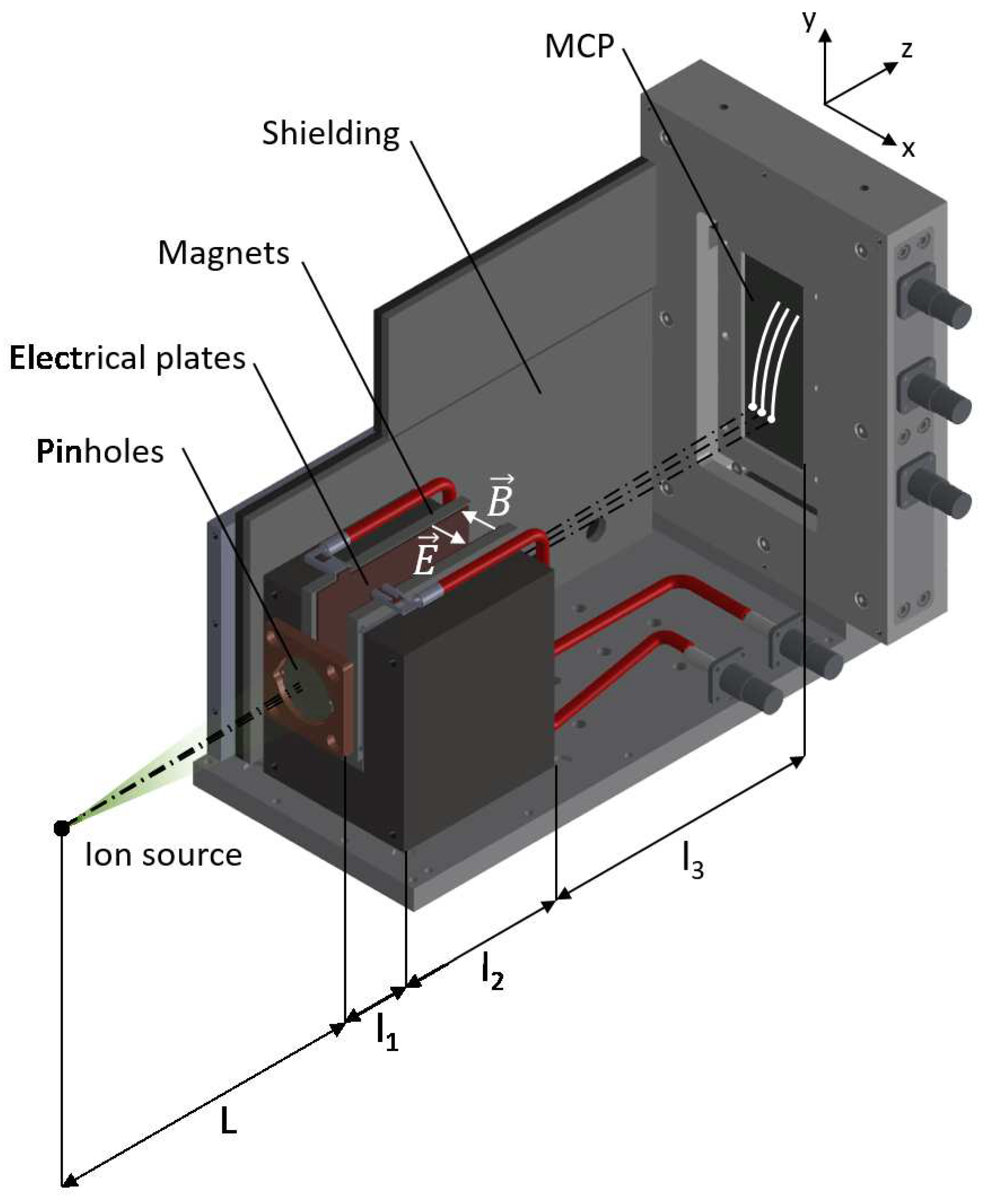
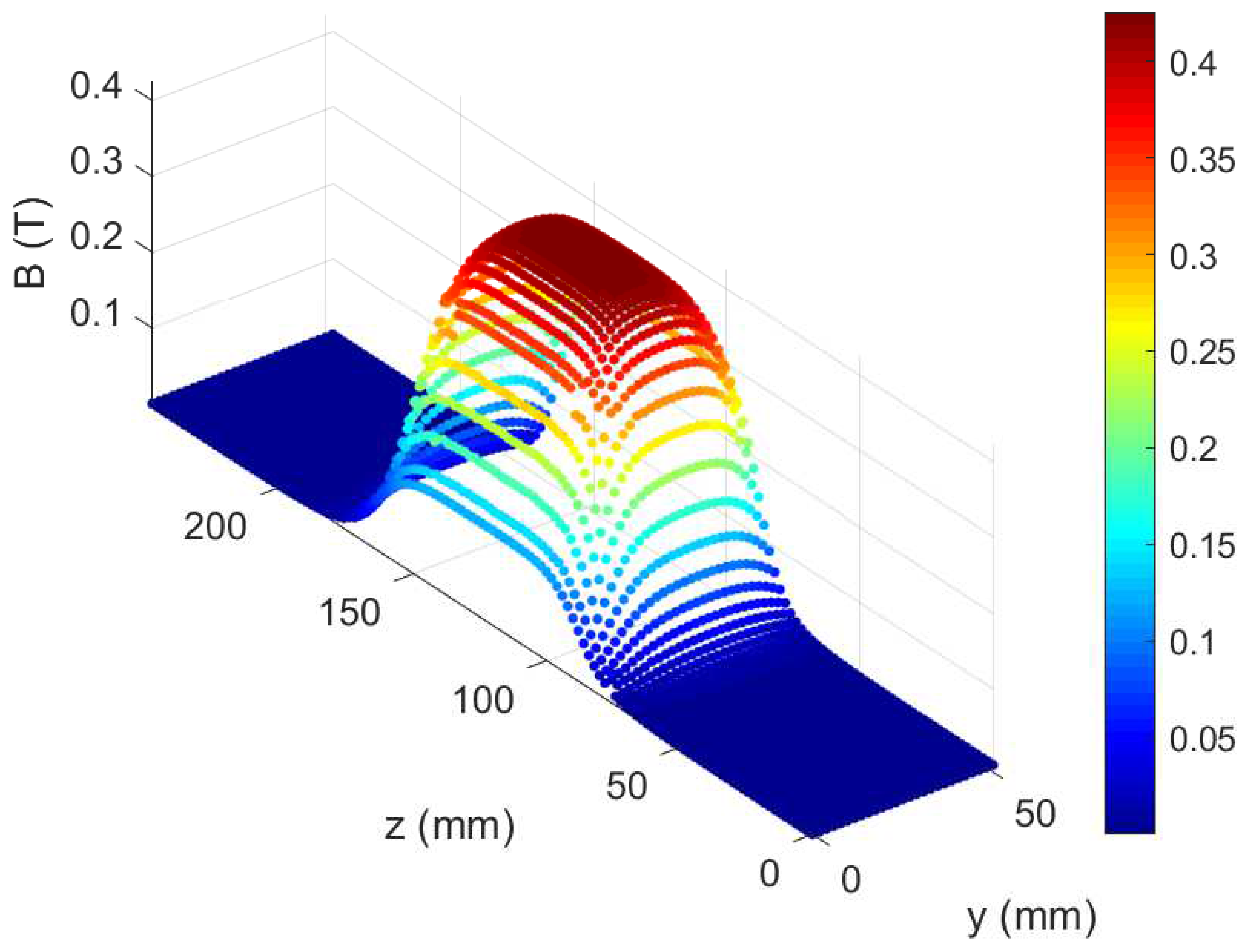
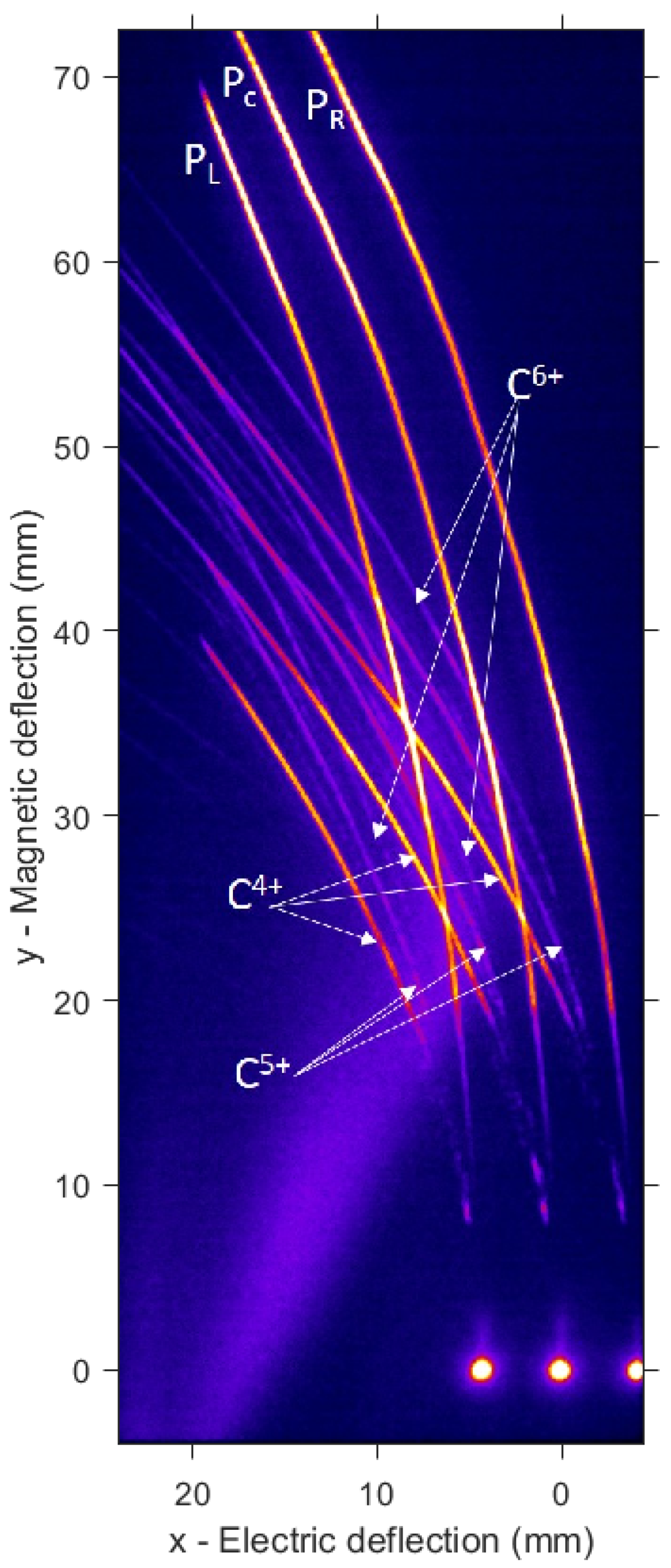
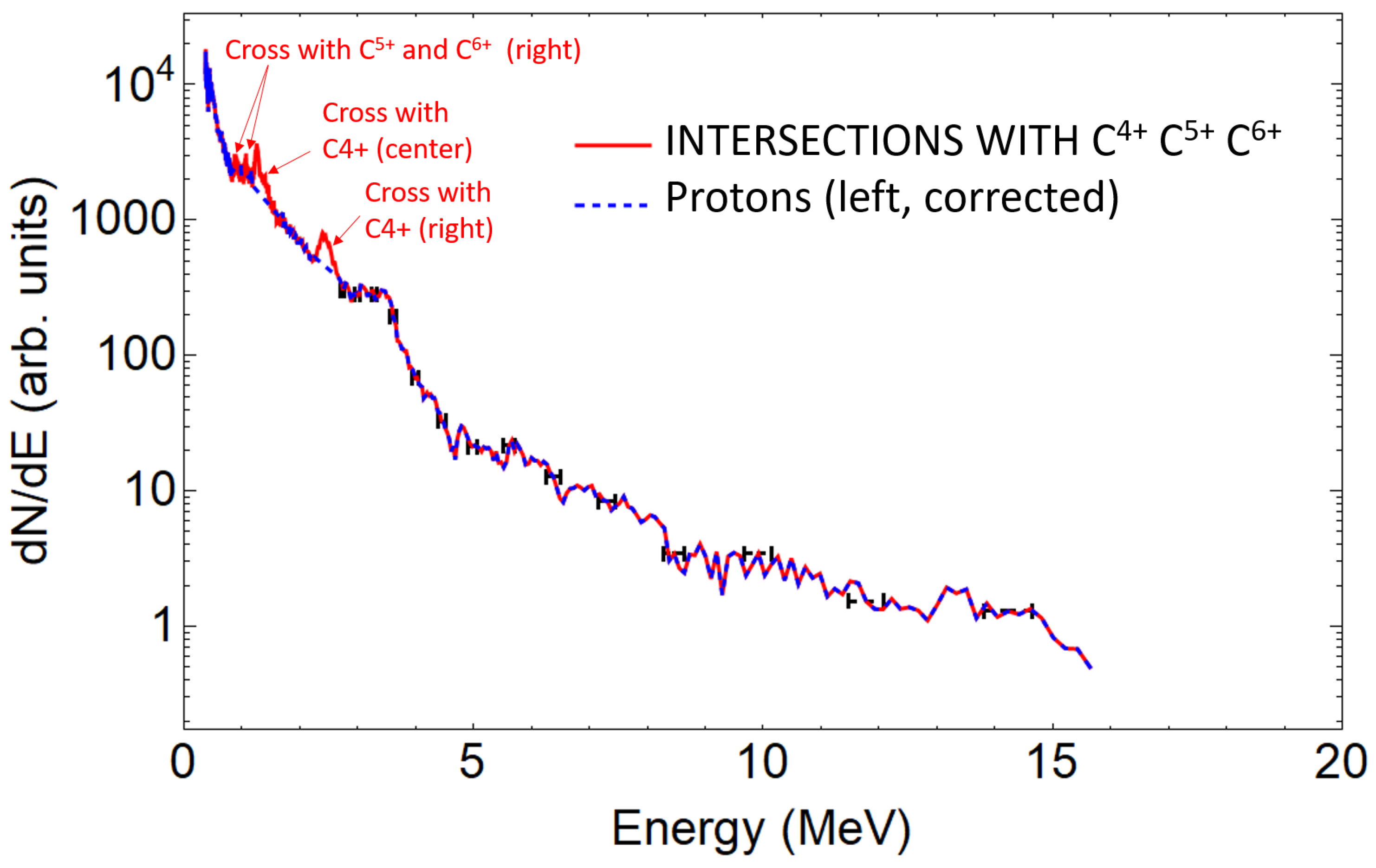
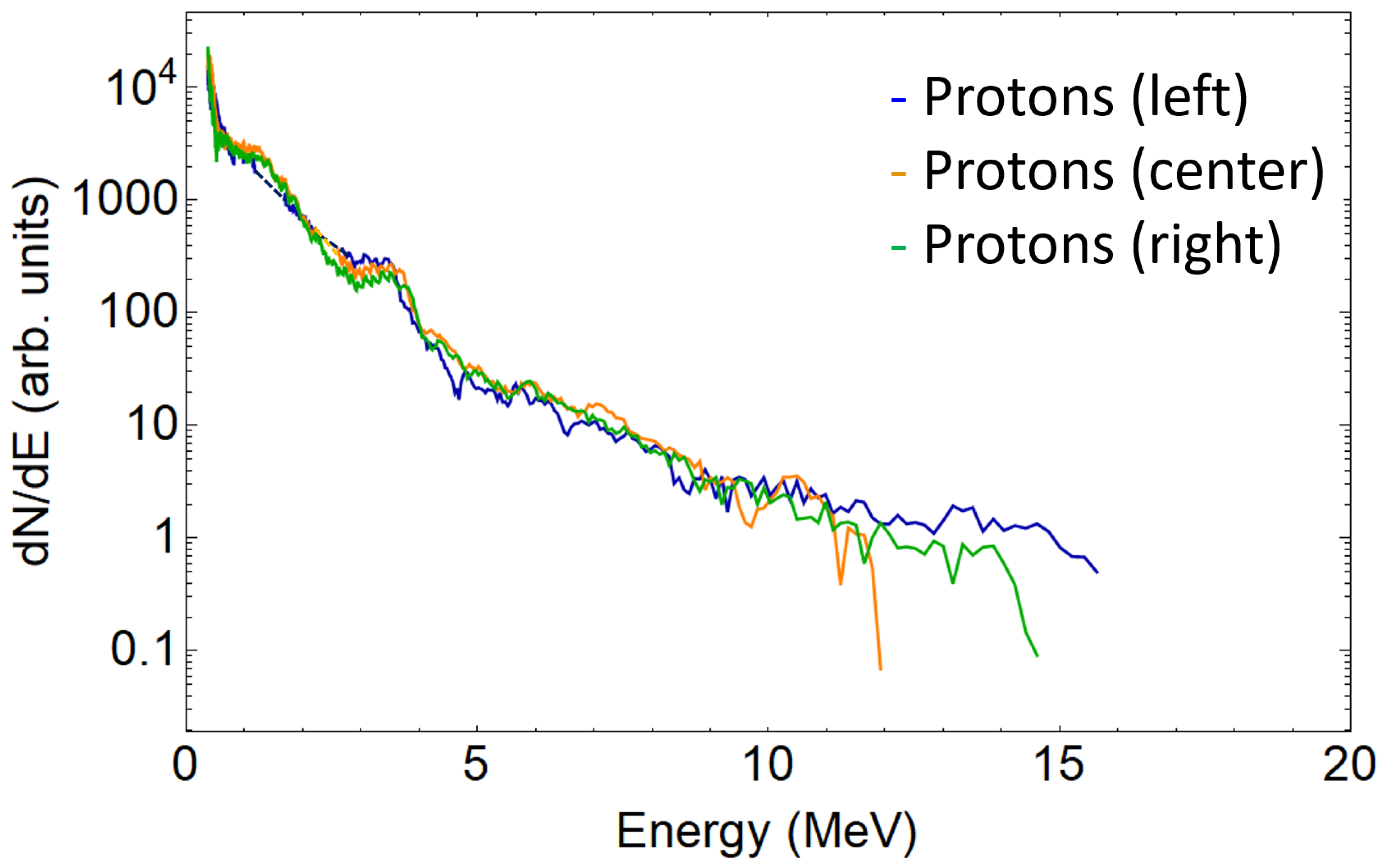

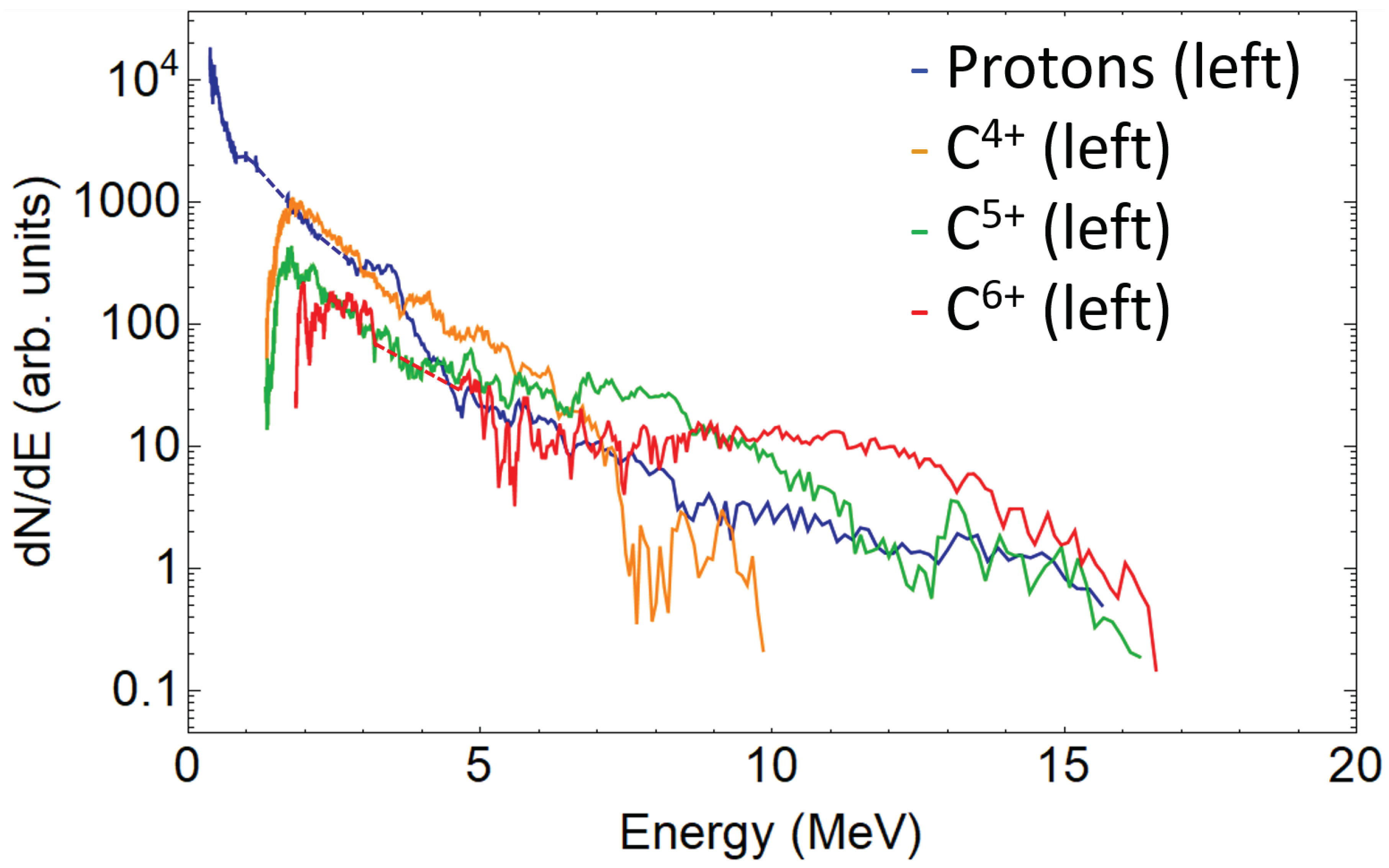
Publisher’s Note: MDPI stays neutral with regard to jurisdictional claims in published maps and institutional affiliations. |
© 2022 by the authors. Licensee MDPI, Basel, Switzerland. This article is an open access article distributed under the terms and conditions of the Creative Commons Attribution (CC BY) license (https://creativecommons.org/licenses/by/4.0/).
Share and Cite
Salgado-López, C.; Apiñaniz, J.I.; Henares, J.L.; Pérez-Hernández, J.A.; de Luis, D.; Volpe, L.; Gatti, G. Angular-Resolved Thomson Parabola Spectrometer for Laser-Driven Ion Accelerators. Sensors 2022, 22, 3239. https://doi.org/10.3390/s22093239
Salgado-López C, Apiñaniz JI, Henares JL, Pérez-Hernández JA, de Luis D, Volpe L, Gatti G. Angular-Resolved Thomson Parabola Spectrometer for Laser-Driven Ion Accelerators. Sensors. 2022; 22(9):3239. https://doi.org/10.3390/s22093239
Chicago/Turabian StyleSalgado-López, Carlos, Jon Imanol Apiñaniz, José Luis Henares, José Antonio Pérez-Hernández, Diego de Luis, Luca Volpe, and Giancarlo Gatti. 2022. "Angular-Resolved Thomson Parabola Spectrometer for Laser-Driven Ion Accelerators" Sensors 22, no. 9: 3239. https://doi.org/10.3390/s22093239
APA StyleSalgado-López, C., Apiñaniz, J. I., Henares, J. L., Pérez-Hernández, J. A., de Luis, D., Volpe, L., & Gatti, G. (2022). Angular-Resolved Thomson Parabola Spectrometer for Laser-Driven Ion Accelerators. Sensors, 22(9), 3239. https://doi.org/10.3390/s22093239






